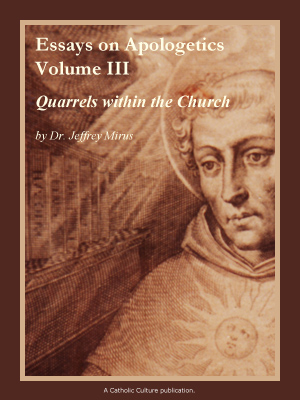The surpassing relevance of Mary’s Jewish roots
By Dr. Jeff Mirus ( bio - articles - email ) | Sep 12, 2018 | In Reviews
Brant Pitre just won’t quit, and we should be grateful. Image Books (Random House) has just sent me an uncorrected proof of the fourth in his series of books exploring the Jewish understanding of key Messianic texts at the time of Christ. The purpose of the books is to shed greater light on the central mysteries of the Catholic Faith. Pitre typically reviews the Jewish understanding of key Scriptural passages and episodes to explain the details of the Church’s Faith, details which resonate deeply with important themes, images, and prophecies under the Old Covenant.
Free eBook:

|
| Free eBook: Essays in Apologetics, Vol. III |
The first of the four was Jesus and the Jewish Roots of the Eucharist: Unlocking the Secrets of the Last Supper, in 2011. The second, in 2014, was Jesus the Bridegroom: The Greatest Love Story Ever Told. In 2016 Pitre wrote The Case for Jesus: The Biblical and historical evidence for Christ. And now he has done the same thing for the Mother of God in Jesus and the Jewish Roots of Mary: Unveiling the Mother of the Messiah. (Note: I provided further information on Pitre’s approach in my review of the second book See: Each of us is destined to marry Jesus Christ).
The author found himself in an excellent position to write this book, not only for professional reasons, but because he can recall the days in which his interest in Mary had waned because he suspected that the Protestants were right in thinking that Catholic beliefs about Mary were “unbiblical”. Now that he is one of the leading experts in how Jews at the time of Christ understood their Scripture, he realizes better than almost anyone else how profoundly consistent Catholic doctrine is with the Jewish reading of the Old Testament books, and so with what knowledgeable people should expect both Our Lord and Our Lady to be, and how they are to be honored.
I will not quote from the book, because there may be slight textual changes in final revisions prior to its release next month. Suffice it to say that in eight very accessible and enriching chapters, Brant Pitre demonstrates convincingly that the Catholic understanding of Mary as the new Eve, the new Ark, the Queen Mother, the perpetual virgin, the mother of God, the new Rachel, and the mother of each of us in the Church—all these are completely consistent with the expectations of the Old Testament, and therefore with an understanding the earliest Christians were well-prepared to receive and explain. It is only later prejudice and Scriptural ignorance which has led so many to denounce Catholic beliefs about and devotion to Mary as somehow contrary to the Bible.
Collateral Reading
Pitre, though a scholar, is an accomplished popular writer. His work is clear and accessible to ordinary readers, never excessively long or over-annotated. The book approaches each point cleanly and concisely, and the author remains keenly aware of the various confusions and prejudices he must dispel. Consequently, I can and do recommend Jesus and the Jewish Roots of Mary to all readers. Exegetes and theologians can skim through the book very quickly to pick up its main points, supplementing their own knowledge. Non-academic readers can dwell on each and every page with significant spiritual profit.
Those who would like to explore more fully the veneration of Mary from the similarly ancient perspective of the first Christian centuries will also enjoy Michael Hesemann’s deeper excursion into the early history, archeology and even legends relating to the Mother of God. Hesemann’s somewhat longer and more detailed book is less an argument than a fascinating exploration. I discussed this book, entitled simply Mary of Nazareth, in parts 4a and 4b of my Sing of Mary series.
One of the most intriguing themes Pitre discusses is the “birth pangs of the Messiah”, a Scriptural image which has a strong connection not with Mary’s miraculous (and painless) delivery of the Christ child, but with her suffering at the foot of the Cross as she cooperated in sorrow with the Passion of her Son in giving birth to the New Covenant—and to all those who receive new life through His Church. I would argue that another important thing to remember is the manner in which these birth pangs—these sufferings—somehow persist in us as the Kingdom of God continually comes into being through the shared suffering of Christ, His mother, and each of its members.
In these dreadful days for the Church in the year 2018, in an era in which human affections have been cruelly separated from their intended natural and spiritual fecundity, understanding the maternal role of Mary is as important as it ever was—and as consoling, too.
All comments are moderated. To lighten our editing burden, only current donors are allowed to Sound Off. If you are a current donor, log in to see the comment form; otherwise please support our work, and Sound Off!







